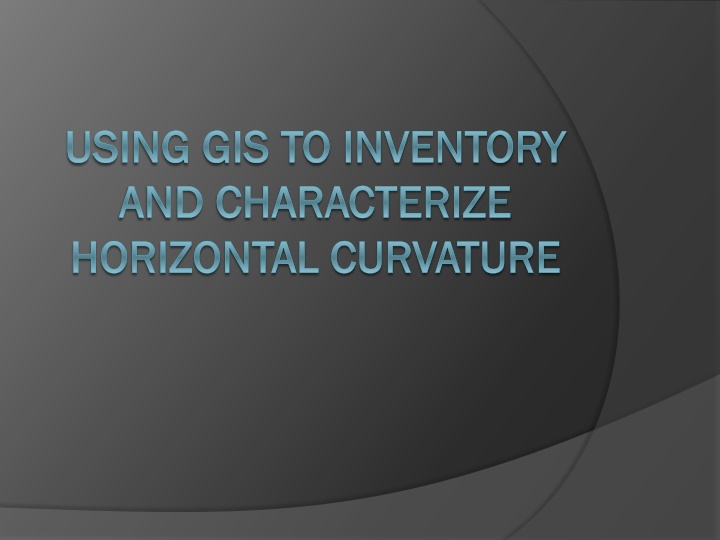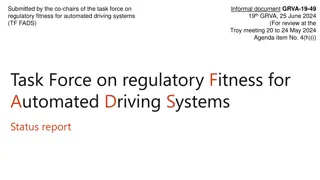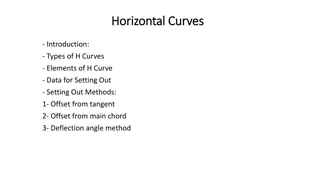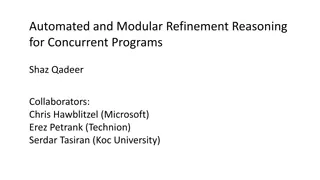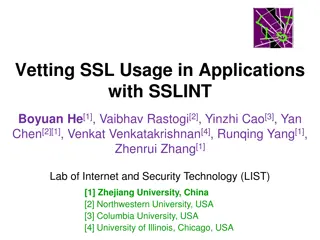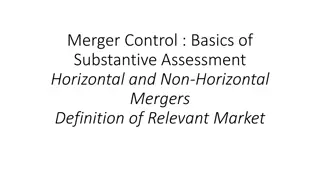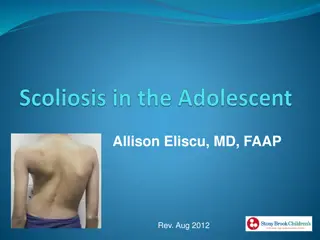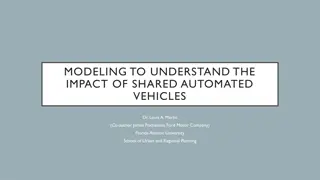Automated Tool for Inventorying and Characterizing Horizontal Curvature in Roadways
Improving highway safety is a priority for transportation departments. This project aims to develop a tool that automates the identification and characterization of horizontal curves in roadway networks using GIS technology. Roadway curvature, including horizontal curves, plays a key role in predicting highway safety by identifying areas for potential improvements. The project focuses on utilizing centerline data to enhance safety measures and address road features that transition between straight sections. Explore the background, objective, and importance of vertical and horizontal curves in roadway safety assessments to understand the significance of this tool in enhancing road safety and efficiency.
Download Presentation

Please find below an Image/Link to download the presentation.
The content on the website is provided AS IS for your information and personal use only. It may not be sold, licensed, or shared on other websites without obtaining consent from the author.If you encounter any issues during the download, it is possible that the publisher has removed the file from their server.
You are allowed to download the files provided on this website for personal or commercial use, subject to the condition that they are used lawfully. All files are the property of their respective owners.
The content on the website is provided AS IS for your information and personal use only. It may not be sold, licensed, or shared on other websites without obtaining consent from the author.
E N D
Presentation Transcript
USING GIS TO INVENTORY USING GIS TO INVENTORY AND CHARACTERIZE AND CHARACTERIZE HORIZONTAL CURVATURE HORIZONTAL CURVATURE
Overview Improving highway safety is a priority for all state transportation departments. Key roadway characteristics can be used to identify sections which would most benefit from safety improvements. Roadway curvature is an important roadway characteristic for predicting highway safety. http://my1970z28.com/pics/etc/etc/delete/Warwick-Crash1.jpg
Objective To develop a tool which can automate the identification and characterization of horizontal curves in a roadway network from its centerline data.
Background Roadway Curvature PA Highway Safety The Highway Safety Manual
Roadway Curvature Curves are roadway features that serve as transitions between straight sections of roadway. There are two distinct types of roadway curves: Vertical Curves Horizontal Curves
Characterizing Horizontal Curves http://www.reviewcivilpe.com/pressfolder/wp-content/uploads/2012/03/horizontal-curves.png
Super Elevation http://ec.europa.eu/transport/road_safety/specialist/knowledge/images/road_image010.gif
PA Highway Statistics (2013) 120,000 miles of total roadway 40,000 miles of roadway owned by the state 124,149 reportable traffic crashes 1208 fatalities 83,089 injuries 99.5 billion vehicle miles traveled 1.21 deaths per hundred million vehicle miles Source: PennDOT (2013)
State Owned Roadway Miles 90,000 80,000 70,000 60,000 50,000 Miles 40,000 30,000 20,000 10,000 - Hawaii Maine Alabama California Vermont Colorado New Jersey New York Oregon Utah Virginia Alaska Delaware Iowa Montana Ohio Arkansas Connecticut Illinois Indiana Nevada South Dakota Washington West Virginia Wyoming Kansas Missouri North Carolina North Dakota Rhode Island South Carolina Idaho Michigan Minnesota Tennessee Texas Arizona Georgia Florida Kentucky Massachusetts Nebraska Dist. of Columbia Louisiana Maryland Mississippi Wisconsin New Mexico Oklahoma New Hampshire Pennsylvania Only Texas, North Carolina and Virginia have substantially more miles of state owned roadway than Pennsylvania. Source: USDOT Federal Highway Administration (2012)
Making Our Roads Safer DOTs have a limited budget for safety improvements. The better the most dangerous sections of roadway can be identified, the more effectively available funding can be used to improve highway safety. Two general approaches Look at crash data Look at roadway characteristics
Using Roadway Characteristics in Highway Safety Highway Safety Manual (HSM) Published by AASHTO (American Association of State Highway & Transportation Officials) Presents methods of estimating expected crash rates from roadway characteristics, crash data and traffic volume. These methods can be used to: Screen the roadway network Estimate the impacts of roadway improvements Evaluate alternatives during roadway design.
Some Key Highway Safety Terms SPF Safety Performance Function (crash prediction models) CMF Crash Modification Factor Also known as an Accident Modification Factor (AMF) Npredicted = Nspf x (CMF1x x CMF2xx x CMFyz) x Cx Counter Measure A safety improvement designed to reduce crash rates
AMF for Horizontal Curve Source: Highway Safety Manual (2010)
Existing Horizontal Curve Data The HSM provides a model for using horizontal curvature to better screen a roadway network. However, DOTs generally lack an inventory of characterized horizontal curves on there roadway networks. Information on horizontal curvature and other roadway characteristics often does not exist and when it does exist is generally buried in highway design documents and is not readily available for use by safety engineers.
Methodology A tool will be developed in ArcGIS using Python. The tool will step through the vertices of roadway features and: Create a spatial inventory of horizontal curves Determine the radius and length of each curve LRS Key Start 01001504701500 01001504900073 LRS Key End 01001504800250 01001504901248 Length (miles) 0.4216 0.2233 Radius (feet) 102 89 (X3, Y3) (X1, Y1) (X2, Y2) LRS Key - CCRRRRSSSSOOOO
Data Sources Roadway Centerline Data PennDOT Bureau of Planning and Research Crash Data PennDOT Bureau of Maintenance and Operations Manually determined horizontal curves on rural two lane roads PSU Professor Eric Donnelly Roadway Design Documents PennDOT Engineering District Offices
Other Efforts ESRI Curve Calculator FDOT Curve Extension NHDOT - Curve Finder Dr. Jeffery Dickey LSU Developed an Excel based tool that characterizes horizontal curvature Dr. Eric Donnell PSU Examined 10,000 miles of rural roadway in PA and manually characterized horizontal curvature
Validation of Approach Manually determined horizontal curve data will be used to examine the validity of the approach. The algorithms in the tool will incorporate parameters which can be adjusted to bring the results of the model into agreement with the manually determined curve data. Process Data Refine Approach Validate Results
Timeline (2015) Submit Paper & Present at Conference Assemble Data Validate and Refine Tool Jan Feb Mar Apr May Jun Jul Aug Sep Oct Nov Dec Author Paper & Prep for Conference Develop Tool
Publications & Conferences Potential Journals SAE International Journal of Transportation Safety Journal of Transportation Safety and Security Journal of Transportation Planning and Technology URISA Journal Potential Conferences Transportation Engineering and Safety Conference (December 2015 in State College PA)
Automating Grade Determination Along a Road Network Grade is also an important roadway characteristic. LiDAR (light detection and ranging) data will be used with PA highway centerline data to associate elevation data with the roadway network at regular intervals. The elevation data will be used to calculate grade.
Acknowledgements Beth King (PSU) Eric Donnell (PSU) Gary Modi (PennDOT)
References Federal Highway Administration (2014). Highway Performance Monitoring System Field Manual American Association of State Highway and Transportation Officials (AASHTO) (2009). Highway Safety Manual Donnell, E. (2013). Safety Performance Functions for Two- Lane Rural Highways and Intersections in Pennsylvania , Presentation at the December 2013 Transportation Engineering and Conference, State College PA Federal Highway Administration, (2012). Highway Statistics Pennsylvania Department of Transportation (2013). Crash Facts and Statistics Khattak, A. and Shamayleh, H. (2005). Highway Safety Assessment through Geographic Information System-Based Data Visualization. J. Comput. Civ. Eng., 19(4), 407 411 Rasdorf, W., Findley, D., Zegeer, C., Sundstrom, C., Hummer, J. (2012). Evaluation of GIS Applications for Horizontal Curve Data Collection , J. Comput. Civ. Eng. 2012.26:191-203.
